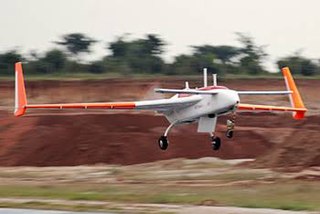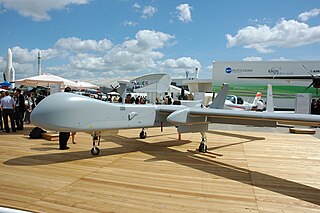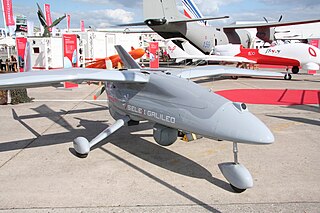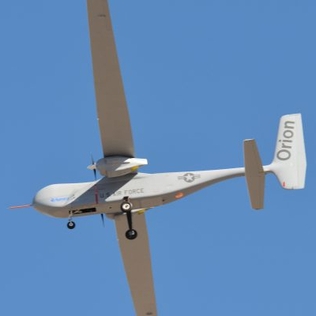Related Research Articles

The Environmental Research Aircraft and Sensor Technology, or ERAST program was a NASA program to develop cost-effective, slow-flying unmanned aerial vehicles (UAVs) that can perform long-duration science missions at altitudes above 60,000 ft (18,000 m). The project included a number of technology development programs conducted by the joint NASA-industry ERAST Alliance. The project was formally terminated in 2003.

The BAE Systems Phoenix was an all-weather, day or night, real-time surveillance Unmanned Air Vehicle. It had a twin-boom UAV with a surveillance pod, from which the imagery was data linked to a ground control station (GCS) that also controlled the aircraft in flight. It was the third generation of UAV in British Army service with the Royal Artillery after SD/1 and Canadair Midge.

The Northrop Grumman Bat is a medium-altitude unmanned air vehicle originally developed for use by the United States Armed Forces. Designed primarily as an intelligence "ISR" gathering tool, the Bat features 30 lb (14 kg) payload capacity that is unmatched in a 10 ft (3.0 m) wing span.

The BAE Systems HERTI is an unmanned aerial vehicle (UAV) developed by the British company BAE Systems. HERTI stands for "High Endurance Rapid Technology Insertion" and was developed in Warton, United Kingdom. The HERTI airframe is based on the J-6 Fregata motor glider designed by Jaroslaw Janowski of J&AS Aero Design in Poland. Its first flight was in December 2004 at the Australian Woomera test range where much of the test flight programme has been undertaken. HERTI was also the first UAV to fly in the UK with the flight being certified by the Civil Aviation Authority.
The Silver Arrow Mini-V is a small reconnaissance UAV developed in Israel in the 1990s.

The BAE Systems Mantis Unmanned Autonomous System Advanced Concept Technology Demonstrator is a British demonstrator programme for Unmanned Combat Air Vehicle (UCAV) technology. The Mantis is a twin-engine, turboprop-powered UCAV with a wingspan of approximately 22 m, broadly comparable to the MQ-9 Reaper. Other partners involved in Phase 1 of the Mantis programme include the Ministry of Defence, Rolls-Royce, QinetiQ, GE Aviation, L-3 Wescam, Meggitt and Lola.

The DRDO Rustom is a medium-altitude long-endurance unmanned air vehicle (UAV) being developed by Defence Research and Development Organisation for the three services, Indian Army, Indian Navy and the Indian Air Force of the Indian Armed Forces. Rustom is derived from the NAL's LCRA developed by a team under the leadership of late Prof Rustom Damania in the 1980s. The UAV will have structural changes and a new engine.

The EADS Harfang, formerly known as Système intérimaire de drone MALE is an unmanned aerial vehicle used by the French Air Force, supplementing the RQ-5 Hunter.

The Falco is a tactical unmanned aerial vehicle (UAV) designed and produced by Selex ES. The UAV is designed to be a medium-altitude, medium-endurance surveillance platform capable of carrying a range of payloads, including several types of high-resolution sensors. A larger variant, the Falco EVO, is capable of carrying larger payloads is also available. Neither system is designed to carry weapons, The launch customer, Pakistan, reportedly wanted the Falco armed, a request that Italy rejected.

The AeroVironment Wasp III Small Unmanned Aircraft System is a miniature UAV developed for United States Air Force special operations to provide a small, light-weight vehicle to provide beyond-line-of-sight situation awareness. The aircraft is equipped with two on-board cameras to provide real-time intelligence to its operators. It is also equipped with GPS and an Inertial Navigation System enabling it to operate autonomously from takeoff to recovery. It was designed by AeroVironment Inc., and was first added to the Air Force inventory in 2007. There are two Wasp variants: the traditional version that lands on land, and a version that lands into the sea or fresh water. The Air Force accepted the Wasp AE in late May 2012, and the U.S. Marine Corps revealed in January 2013 that they had ordered the Wasp AE. The Wasp AE is designated as the RQ-12A.

The AeroVironment T-20 unmanned aerial vehicle (UAV) is a medium range, composite aircraft capable of internal and external payloads. Launched from a portable catapult, it can be recovered with a shipboard landing system, or belly land on unimproved surfaces. The T-20 carries a retractable gimbal-mounted, digitally stabilized, electro-optical/infrared (EO/IR) camera that relays video in real time via a C-band LOS data link to the ground control station (GCS). Powered by a 4-stroke, fuel injected gasoline engine, the aircraft burns 2 lb (910 g) of fuel per hour at cruise. AeroVironment, Inc. acquired Arcturus UAV, the original developer of JUMP 20 and T-20 on February 22, 2021.
Jasoos is an unmanned aerial vehicle designed and manufactured by SATUMA of Pakistan. The Jasoos II Bravo+ variant is currently operational with the Pakistan Air Force.

The Patroller is a French medium-altitude long-endurance unmanned aerial vehicle developed and manufactured by Safran Electronics & Defense. The airframe is based on the Stemme ASP S15 motor glider.

The UMS Skeldar V-200 is a medium-range VTOL UAV developed by the Swedish aerospace company Saab. The Skeldar can be used for surveillance, intelligence gathering, light cargo transportation, and electronic warfare.

The Sensintel Silver Fox UAV is an Unmanned aerial vehicle (UAV) that can conduct autonomous aerial surveillance imaging. The Silver Fox UAV is designed to provide low cost aerial surveillance imaging and carry sensor payload packages weighing up to four pounds. Video images are transmitted from Silver Fox to a ground station for quick reference. One ground station can simultaneously operate ten units.
The GIDS Uqab is a tactical unmanned reconnaissance aerial vehicle built and developed by the Global Industrial Defence Solutions (GIDS) for the joint drone program of the Pakistan Navy and Pakistan Army. The Uqab is a tactical system which can be used for damage assessment, reconnaissance operations, artillery fire corrections, and can perform other variety of security and military operations.

The Orion is a Medium-altitude long-endurance unmanned aerial vehicle (UAV) developed by Aurora Flight Sciences.

Global Industrial & Defence Solutions (GIDS) is a Pakistani state-owned defence conglomerate, and the country's largest defence manufacturer, offering products for military applications. GIDS has exported to 16+ countries and is currently under engagement with 30+ countries across the globe.

The TAI Aksungur is an unmanned combat aerial vehicle (UCAV) built by Turkish Aerospace Industries (TAI) for the Turkish Armed Forces. Using existing technology from the TAI Anka series of drones, it is the manufacturer's largest drone with payload capacity for mission-specific equipment. It is intended to be used for long-term surveillance, signals intelligence, maritime patrol missions, or as an unmanned combat aerial vehicle. TAI planned to integrate weapon packages and put the Aksungur into production in early 2020. The first unit was delivered to the Turkish Naval Forces on 20 October 2021.
The Shahpar-ll is an unmanned combat aerial vehicle (UCAV) built by Global Industrial Defence Solutions of Pakistan. It is currently in production following the completion of a test and qualification phase.
References
- 1 2 Donald, David (21 Feb 2013). "UAVs from Pakistan". IDEX 2013 News. Jane's IHS. Retrieved 5 March 2013.
- 1 2 3 CAVAS, CHRISTOPHER P. (19 Feb 2013). "IDEX: Explosion of UAVs at Exhibit". Defense News. Archived from the original on April 10, 2013. Retrieved 5 March 2013.
- 1 2 "SHAHPAR UAV System". Official GIDS website. Global Industrial Defence Solutions (GIDS). Archived from the original on 23 March 2013. Retrieved 16 March 2013.
- ↑ "No PR-188/2013-ISPR". Inter Services Public Relations (ISPR). Rawalpindi. 25 November 2013.